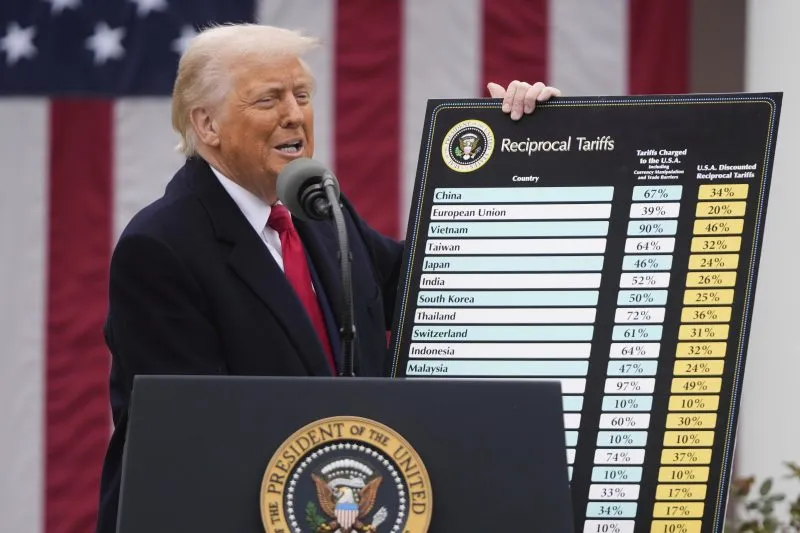President Trump Announces 10% Baseline Tariff on All Imports to Rebalance Global Trade
In a sweeping move aimed at restoring U.S. economic sovereignty and reversing decades of what he described as “unfair trade practices,” President Donald J. Trump on Wednesday announced the implementation of a 10% baseline tariff on all imports, effective April 5, 2025. The announcement, delivered in a fiery address from the White House Rose Garden, marks a sharp reorientation of U.S. trade policy and is expected to have wide-reaching global implications.
April 2 Declared “Liberation Day”
Standing before American steelworkers, farmers, and manufacturing workers, Trump declared April 2 as “Liberation Day”, calling it the beginning of a new era of economic independence.
“For too long, other nations have taken advantage of our open markets while imposing barriers to our products. Those days are over,” said Trump. “Now it’s our turn to prosper.”
Trump emphasized that the new tariff strategy is not just about protecting domestic industries, but about revitalizing American jobs, paying down the national debt, and reversing the effects of decades of industrial decline.
A Return to Historical Trade Roots
Framing the move as a return to America’s historical foundations, Trump pointed out that the U.S. thrived for more than a century as a tariff-backed nation. Between 1789 and 1913, tariffs provided the primary source of federal revenue, and the U.S. became proportionately wealthier than at any point since.
“We were collecting so much money so fast, we didn’t know what to do with it. Isn’t that a nice problem to have?” he said.
Reciprocal Tariffs with a “Discounted Fairness” Model
Alongside the 10% baseline, Trump introduced a “discounted reciprocal tariff” policy. For nations with egregiously high tariffs or non-monetary trade barriers, the U.S. will calculate a new tariff—roughly half of what those countries charge American products. This, Trump argued, is a generous offer given the magnitude of trade imbalances.
“If you want your tariff rate to be zero, then you build your product right here in America,” he said. “Because there is no tariff if you build your plant, your product in America.”
A chart released by the White House showcased startling disparities in global trade terms. For example:
- Vietnam imposes 90% tariffs on U.S. goods; the U.S. will now impose 46%.
- China levies 67%; the U.S. response: 34%.
- India charges 52%; U.S. response: 26%.
- Even close allies like Japan (46%), South Korea (50%), and the EU (39%) face new tariffs under this plan.
In contrast, countries already charging lower or equal rates will be subject only to the flat 10%.
Trade Realignment in the Name of National Security
Trump’s message went beyond economics. He positioned the tariff policy as a matter of national security, saying it would prevent foreign adversaries from hollowing out American industry and eroding the country’s strategic strength.
“Foreign leaders have stolen our jobs. Foreign cheaters have ransacked our factories. Foreign scavengers have torn apart our once beautiful American Dream,” he declared. “We will supercharge our domestic industrial base.”
He also cited currency manipulation, intellectual property theft, and environmental double standards—what he termed “filthy pollution havens”—as practices that gave foreign competitors unfair advantages over American businesses.
Policy Implementation and Global Response
The tariff policy is set to take effect immediately on April 5, allowing minimal time for trading partners to respond or negotiate exemptions. Administration officials say the U.S. Trade Representative and Department of Commerce are finalizing implementation details.
While supporters argue the move will revive American manufacturing and reduce dependence on foreign supply chains, critics warn of retaliatory tariffs, supply chain disruptions, and increased consumer prices.
A Resurgent Economic Nationalism
This bold trade initiative underscores President Trump’s continued commitment to economic nationalism and “America First” policies. By leveraging tariffs as both an economic and diplomatic tool, the administration aims to force trading partners back to the negotiating table under new terms that favor domestic production and fair market access.
Whether this approach delivers on its ambitious goals or provokes international backlash remains to be seen—but for now, it signals a definitive shift in America’s posture on global trade.

